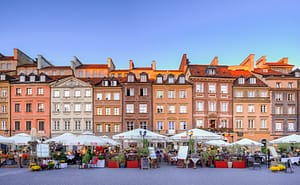Warsaw’s history has had more than its share of ups and downs. But like the essence of the Polish character, Warsaw has managed to return from the brink of destruction time and time again.
The first semblance of a town sprang up around the beginning of the 14th century, when the dukes of Mazovia built a stronghold on the site of the present Royal Castle. In 1413 the dukes chose Warsaw as their seat of power, and things went swimmingly for over 100 years until, in 1526, the last duke died without an heir. The burgeoning town – and the whole of Mazovia – fell under the direct rule of the king in Kraków and was incorporated into royal territory.
Warsaw’s fortunes took a turn for the better after the unification of Poland and Lithuania in 1569, when the Sejm (the lower house of parliament) voted to make Warsaw the seat of its debates because of its central position in the new, larger country. The ultimate ennoblement came in 1596, when King Zygmunt III Waza decided to move his capital from Kraków to Warsaw.
The Swedish invasion from 1655 to 1660 was not kind to Warsaw, but the city recovered and continued to develop. Paradoxically, the 18th century – a period of catastrophic decline for the Polish state – witnessed Warsaw’s greatest prosperity. A wealth of palaces and churches was erected, and cultural and artistic life flourished, particularly during the reign of the last Polish king, Stanisław August Poniatowski.
In 1795 the city’s prosperity was again shattered. Following the partition of Poland, Warsaw’s status was reduced to that of a provincial town of the Russian Empire. When Napoleon arrived in 1806 on his way to Russia, things started looking up. The warring Frenchman created the Duchy of Warsaw and the city became a capital once more. The celebrations were brief, however, as in 1815 Warsaw, and much of the rest of Poland, fell back under Russian rule.
After WWI Warsaw was reinstated as the capital of newly independent Poland, and the urban development and industrialisation begun in the late 19th century continued. By 1939 the city’s population had grown to 1.3 million. This included 380,000 Jews, who had long been a significant part of Warsaw’s population.
German bombs began to fall on 1 September 1939 and a week later the city was besieged; despite brave resistance, Warsaw fell in a month. The conquerors terrorised the local population with arrests, executions and deportations, and a Jewish ghetto was built. The city’s residents rebelled against the Germans twice; first came an eruption in the Jewish ghetto in April 1943, followed by the general Warsaw Rising in August 1944. Both revolts were cruelly crushed.
At the end of the war, the city of Warsaw lay in ruins and 800,000 people – more than half of the prewar population – had perished. (By comparison, the total military casualties for US forces in WWII was 400,000, for UK forces 326,000.) A massive rebuilding project was undertaken soon after, including the meticulous reconstruction of the historic Old Town.
Despite over 40 years of Communist rule, the city adapted well to the fall of the regime. As the business centre of Poland, Warsaw became the focus of economic growth, and nowadays corporate towers have joined Stalin’s Palace of Culture on the city skyline.

